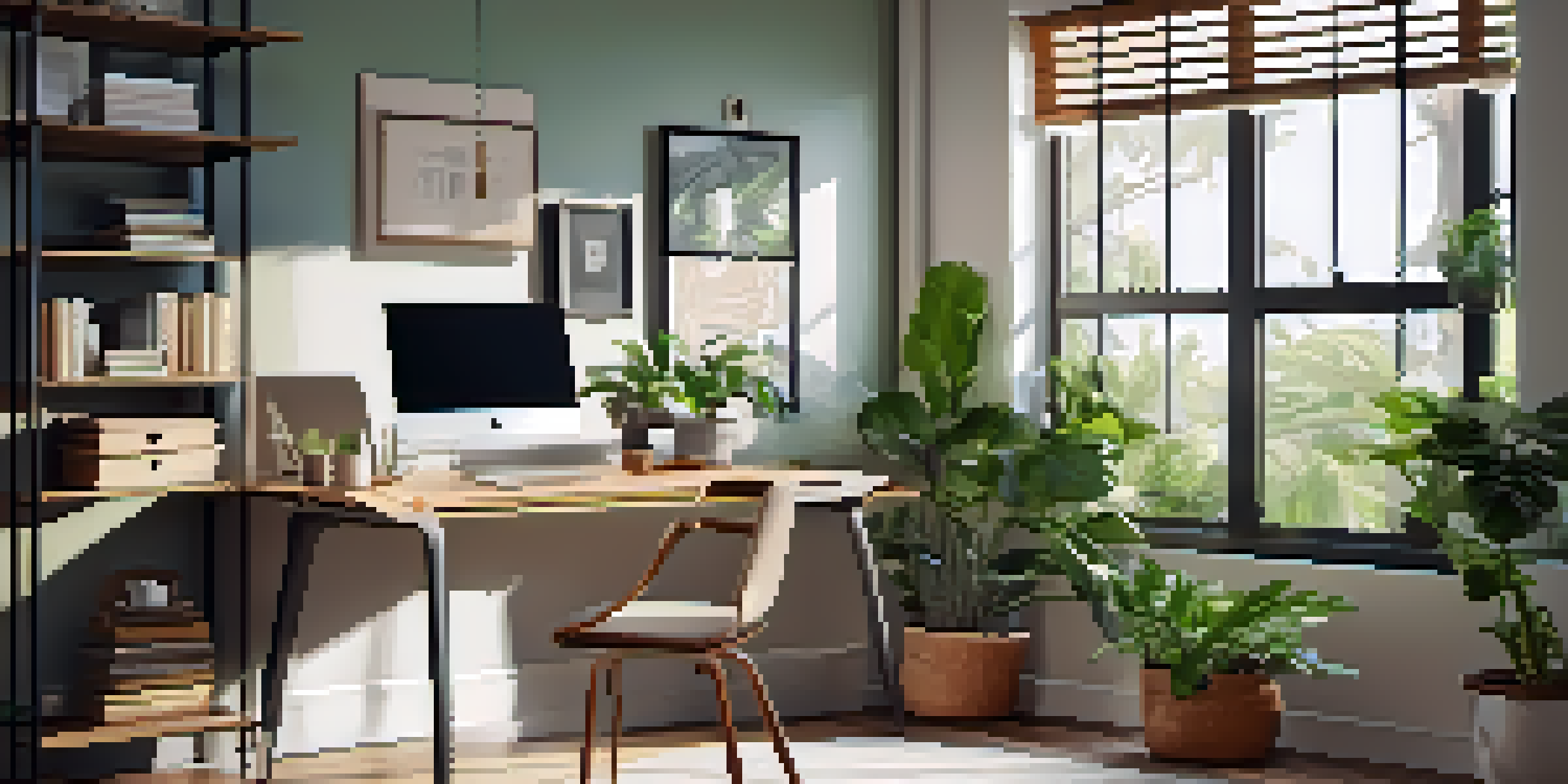Creating a Home Office that Encourages Regular Breaks

Designing a Comfortable Work Space
Creating a home office starts with designing a comfortable work space. Your chair and desk should support your body, encouraging good posture while you work. A comfortable environment can help you focus better, but it also sets the stage for regular breaks. This means choosing furniture that invites you to stand or move around.
Take care of your body. It's the only place you have to live.
Consider using a sit-stand desk that allows you to adjust your position throughout the day. Incorporating cushions or ergonomic chairs can enhance comfort and reduce fatigue. When your physical space feels good, you’re more likely to take those necessary breaks instead of grinding through discomfort.
Additionally, personalize your workspace with items that inspire you. This could be a plant, some artwork, or even a motivational quote. Having a space that feels inviting and uplifting encourages you to step away for breaks, rejuvenating your creativity and productivity.
Incorporating Nature into Your Office
Bringing nature into your home office can significantly impact your well-being. Plants not only purify the air but also boost your mood, making you more likely to take breaks. Studies show that being around greenery can reduce stress and increase focus, which is essential for a productive work environment.

Consider placing a few houseplants on your desk or in the corners of your office. They serve as a gentle reminder to step away and reconnect with the world outside. If you can, position your desk near a window to enjoy natural light, which is known to improve energy levels and overall morale.
Design a Comfort-Focused Workspace
Creating a comfortable work environment with ergonomic furniture and personalized touches encourages breaks and boosts productivity.
When you take breaks, step outside for a moment to enjoy fresh air and the sights and sounds of nature. This simple act can recharge your mind and body, making you more effective when you return to work.
Establishing a Break Schedule
One effective way to ensure you take regular breaks is to establish a break schedule. This means setting specific times throughout your workday to step away from your desk and recharge. For example, you might follow the Pomodoro Technique, which involves working for 25 minutes and then taking a 5-minute break.
Nature does not hurry, yet everything is accomplished.
Having a clear plan helps you avoid the trap of working straight through the day without rest. Use timers or apps to remind you when it's time to take a break. This structure can help improve your focus during work periods and make your breaks feel like a reward.
Remember, breaks can be short but still effective. Use this time to stretch, walk around your home, or grab a healthy snack. Keeping these breaks consistent can help create a habit of stepping away, ultimately boosting your overall productivity.
Creating a Relaxation Zone
Designating a relaxation zone in your home office can be a game-changer. This area should be separate from your main workspace and designed for comfort and tranquility. It could be a cozy chair with a blanket, a small bookshelf, or even a meditation corner with calming decor.
When it's time for a break, move to this zone to unwind and reset your mind. Engaging in a quick mindfulness exercise or reading a few pages of a book can significantly reduce stress levels. By having a specific space dedicated to relaxation, you’re more likely to take those breaks seriously.
Incorporate Nature for Well-being
Bringing plants and natural light into your office can enhance mood and focus, promoting regular breaks for improved mental health.
Make sure this relaxation area is inviting and free from distractions. This way, you’ll look forward to stepping away from your desk instead of feeling guilty for taking time off.
Utilizing Technology to Your Advantage
Technology can be a powerful ally in encouraging regular breaks. Utilize apps that remind you to stand up, stretch, or take a walk. Some applications even track your productivity and suggest when to take breaks based on your work patterns.
For instance, tools like Time Out or Stretchly provide gentle reminders, helping you avoid the trap of losing track of time. These notifications can be a helpful nudge, ensuring you prioritize your well-being throughout the day.
Moreover, consider using noise-canceling headphones or relaxing background music to create a focused atmosphere. When you pair technology with intentional breaks, you create a balanced work environment that enhances productivity and well-being.
Embracing Movement During Breaks
Incorporating movement during your breaks is essential for both physical and mental health. Simple stretches or quick exercises can invigorate your body and refresh your mind. Even a brief walk around your house can stimulate blood flow and combat the lethargy that can set in during long work hours.
You might also consider doing a short yoga session or a few jumping jacks. These activities don’t require a lot of time but can make a significant difference in how you feel. Plus, moving around can help break up the monotony of sitting for long periods.
Establish Boundaries for Balance
Setting clear boundaries between work and break times helps maintain focus and ensures that both productivity and relaxation are prioritized.
Encouraging movement not only enhances your physical health but also promotes creativity. When you allow your mind to wander during these active breaks, you may find inspiration for your work that you wouldn’t have thought of while sitting at your desk.
Setting Boundaries for Work and Breaks
Establishing clear boundaries between work and breaks is crucial for maintaining balance. This means communicating your schedule to those around you and sticking to the times you've set for work and relaxation. When you respect these boundaries, you signal to yourself that both work and breaks are important.
Consider using visual cues like a 'do not disturb' sign during work hours or a specific outfit that puts you in a work mindset. This helps create a mental separation between work time and break time, ensuring you fully engage in each.

When it’s time for a break, allow yourself to step away completely. This means resisting the urge to check emails or messages. By creating this separation, you can return to work feeling refreshed and ready to tackle your tasks with renewed energy.